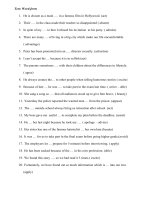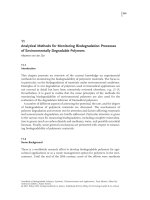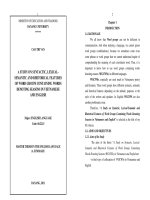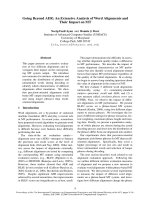Processes of word formation-morphology-lane.
Bạn đang xem bản rút gọn của tài liệu. Xem và tải ngay bản đầy đủ của tài liệu tại đây (8.59 MB, 27 trang )
LANE 333 MORPHOLOGY
2012 – Term 1
+
PROCESSES OF
WORD FORMATION
By:
Dr. Shadia Y. Banjar
Dr. Shadia Yousef Banjar
10
/>
1
11/15/2011
SOURCES OF WORDS
ORIGINAL
WORDS
BORROWED
WORDS
ENGLISH
NEW WORDS
ENGLISH LANGUAGE
Dr. Shadia Yousef Banjar
2
11/15/2011
English gets new words by means of
easily definable processes employed
by users of English.
WORD FORMATION PROCESSES
NEW ENGLISH WORDS
Dr. Shadia Yousef Banjar
3
11/15/2011
WORD FORMATION
PROCESSES
• COMPOUNDING
• DERIVATION
• INVENTION
• ECHOISM
• CLIPPING
• ACRONYMY
• BLENDING
• BACKFORMATION
• FOLK
ETYMOLOGY
• ANTONOMASIA
• REDUPLICATION
Dr. Shadia Yousef Banjar
4
11/15/2011
A. Compounding
Compounding is the joining of two
or more Words into a Single Word,
as in hang glider ,breakfast , longhaired.
Dr. Shadia Yousef Banjar
5
11/15/2011
cont.,
Compounding
•Compounding is the joining of two or more Words
into a Single Word,
• Such words are called compounds.
•They contain two or more words.
• Compounds may be written as:
One word as in : cornflakes
A hyphenated word as in : long-haired
Two words as in : high school
• compound words may take three forms.
•They may be an “open compound”, a “hyphenated
compound”, or a “closed compound”:
Examples:
1. sweet potato
(open compound)
2. mother-in-law
(hyphenated compound)
3. secondhand
(closed compound)
Dr. Shadia Yousef Banjar
6
11/15/2011
B. Derivation
Derivation is the forming of new words
by combining derivational affixes or
bound bases with existing Words , as
in: teleplay, re-ask.
Dr. Shadia Yousef Banjar
7
11/15/2011
cont.,
Derivation
•Derivation is the forming of new words by
combining derivational affixes or bound bases with
existing words.
EXAMPLES:
disadvise
emplane
ecosystem
coachdom
• Usually invented in the heat of speaking and
writing.
•They are immediately understandable because we
know the meaning of the parts.
Dr. Shadia Yousef Banjar
8
11/15/2011
C. Invention
Now and then new words are totally
invented like Kodak and Goof.
Few of them find their way in the
common vocabulary.
Dr. Shadia Yousef Banjar
9
11/15/2011
cont.,
Invention
• Coining is the creation of new words without reference to the existing
morphological resources of the language, that is, solely out of the sounds
of the language.
• Coining is very rare, but the most typical sources are invented trade
names for commercial products that become general terms (usually
without capital letters) for any version of that product.
OLDER EXAMPLES:
aspirin
nylon
vaseline
zipper
MORE RECENT EXAMPLES
kleenex
teflon
tylenol
xerox
Dr. Shadia Yousef Banjar
10
11/15/2011
D .Echoism
Echoism is the formation of words
whose sound suggest their meaning
like hiss and peewee. The sound is
either natural like the roar of a
waterfall or artificial like the clang
of a bell.
Dr. Shadia Yousef Banjar
11
11/15/2011
cont.,
Echoism
In literature, ECHOISM is referred to as
‘onomatopoeia’.
EXAMPLES:
click
murmur
whisper
Dr. Shadia Yousef Banjar
12
11/15/2011
E. Clipping
Clipping means cutting off the beginning or
the end of a word or both leaving a part to
stand for the whole ;lab , dorm , prof ,
exam.
The back-clipped words are those words that
lose their forepart , like plane and phone.
Dr. Shadia Yousef Banjar
13
11/15/2011
cont.,
Clipping
Clipping is the word formation process in which a word is reduced or
shortened without changing the meaning of the word.
• There are four types of clipping:
1. back clipping,
2. fore-clipping,
3. middle clipping, and
4. complex clipping.
Back clipping is removing the end of a word as in gas from gasoline.
Fore-clipping is removing the beginning of a word as in gator from
alligator.
Middle clipping is retaining only the middle of a word as in flu from
influenza.
Complex clipping is removing multiple parts from multiple words as in
sitcom from situation comedy.
• Some of the most common products of clipping are names--Liz, Ron,
Rob, Sue, and so on.
•
/>Dr. Shadia Yousef Banjar
14
11/15/2011
F. Acronoymy
Acronomy is the process whereby a word is
formed from the initials or beginning segments
of a succession of words.
EXAMPLES:
NATO( North Atlantic Treaty Organization)
radar (radio detecting and ranging).
Dr. Shadia Yousef Banjar
15
11/15/2011
cont.,
Acronoymy
•Initialisms and Acronyms are shortenings, build from the initial letters in a phrase
or name. While acronyms are pronounced as single words (NASA, AIDS),
initialisms are pronounced ''as a sequence of letters'' (DNA, USA).
(Finegan 2007, 48)
•Some acronyms even become words of our everyday language, such as laser or
zip code. But the most famous word based on a shortening is the initialism OK.
•Initialisms and acronyms can be sub-divided into a few groups:
1. Acronyms containing non-initial letters (Interpol - International
Criminal Police Organization, radar - radio detection and ranging)
2. Pronounced as a combination of initialism and acronym (CD-ROM,
JPEG)
3. Recursive initialisms, in which the abbreviation refers to itself (PHP
- PHP hypertext preprocessor)
4. Pseudo-initialisms, which consist of a sequence of characters that,
when pronounced as intended, invoke other, longer words (IOU – I
owe you, CU – See you). This kind of initialism is frequently seen on the
internet.
5. Initialisms whose last abbreviated word is often redundantly
included anyway (PIN number)
Dr. Shadia Yousef Banjar
16
11/15/2011
G. Blending
•Blending is the fusion of two words into
one ,usually the first part of one word
with the last part of another, as in
gasohol, from gasoline and alcohol.
•The two classes, blends and clipped
words, are not sharply separated, and
some words may be put into either class.
Dr. Shadia Yousef Banjar
17
11/15/2011
cont.,
Blending
Blending involves taking two or more words,
removing parts of each, and joining the residues
together to create a new word whose form and
meaning are taken from the source words.
EXAMPLES:
• smog = smoke + fog
• brunch = breakfast + lunch
• motel = motor + hotel
• webinar = (worldwide) web + seminar.
• transistor = transfer + resistor
• autobus = automobile + omnibus
• escalator = escalade + elevator
smog
Dr. Shadia Yousef Banjar
fog
smoke
18
11/15/2011
H. Back-formation
Backformation is the formation of new words by the
removal of an affix. It may be defined as the
formation of a word from one that looks like its
derivative. When a backformation becomes established in
the language, we can only tell that it is a backformation if we
know the etymology of the words in question.
EXAMPLES:
•sculpt (from sculptor),
•burgle (burglar),
•proofread (proofreading),
•scavenge (scavenger)
•to vacuum (vacuum cleaner),
•air-condition (air- conditioning),
•skydive (skydiving),
•babysit (babysitting).
Dr. Shadia Yousef Banjar
19
11/15/2011
I. Folk Etymology
Changing a word, in part or in whole, to make
it more understandable and more like familiar
words.
EXAMPLES:
•Type A (foreign words):
Cockroach was borrowed from Spanish cucaracha
but was folk-etymologized as cock + roach.
•Type B (one part becomes obsolete):
sand-blind(as if "blinded by the sand") from Old
English sam-blind "half-blind" (sam- is a oncecommon prefix cognate with "semi-").
Dr. Shadia Yousef Banjar
20
11/15/2011
J. Antonomasia
Antonomasia means the formation
of common noun, a verb, or an
adjective from the name of a person
or place.
Examples:
sandwich(from Sandwich who once spent
twenty-four hours at the gaming table with no
other refreshment than some slices of cold beef
between slices of toast).
Dr. Shadia Yousef Banjar
21
11/15/2011
cont.,
Antonomasia
Frisben (from the Frisbie Bakery in Bridge
Water),
Connecticut (whose pie tins were used for a
throwing game),
Vandal (from the vandals a Germanic people who
overran southern Europe 1500 years ago and sacked
and looted Rome in the fifth century).
• Names from history and literature have
given us man common nouns:
A lover for instance may be called a romeo, a
don juan, a casanova.
Dr. Shadia Yousef Banjar
22
11/15/2011
K. Reduplication
•Reduplication is the process of forming a new
word by doubling a morpheme, usually with
a change of vowel or initial consonant, as
in pooh-pooh, tiptop, And hanky-panky .
•The basic morpheme is the second half, like
dilly-dally, but it may be the first half, tick
tock, or both halves, like singsong, neither
half, like boogie-woogie.
Dr. Shadia Yousef Banjar
23
11/15/2011
cont.,
Reduplication
•The term “REDUPLICATION” involves three
meanings :
1.The process.
2.The result of the process (that is, the
new word).
3. The element repeated
• The repeated element is the basic or
originating morpheme.
•The new word is called twin-words.
Dr. Shadia Yousef Banjar
24
11/15/2011
teeny-weeny
tiptop
repetition
with
Change of
vowel
repetition
with
Change of
initial
consonant
tick-tick
repetition
without
change
TWINWORDS
Dr. Shadia Yousef Banjar
25
11/15/2011









